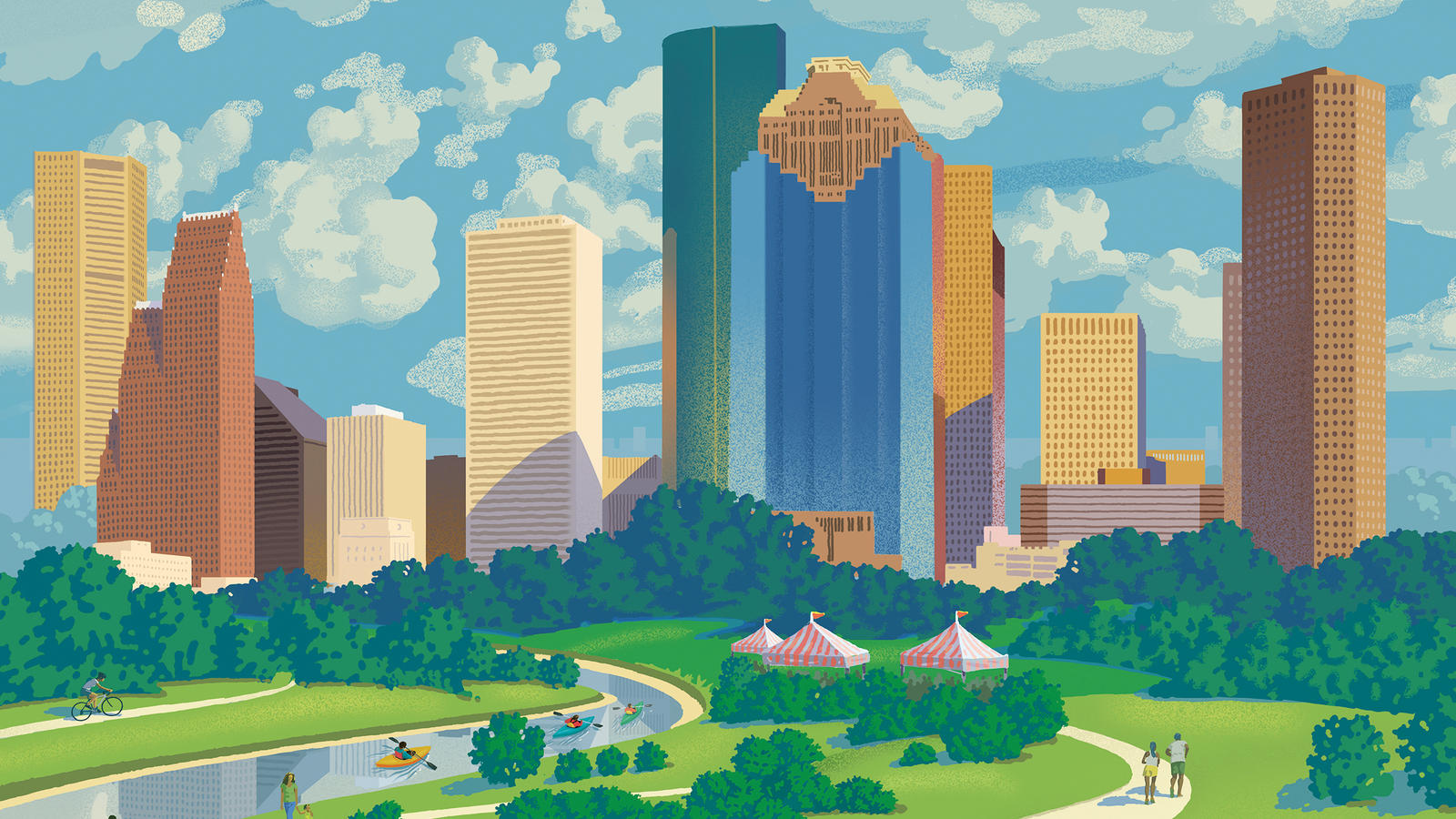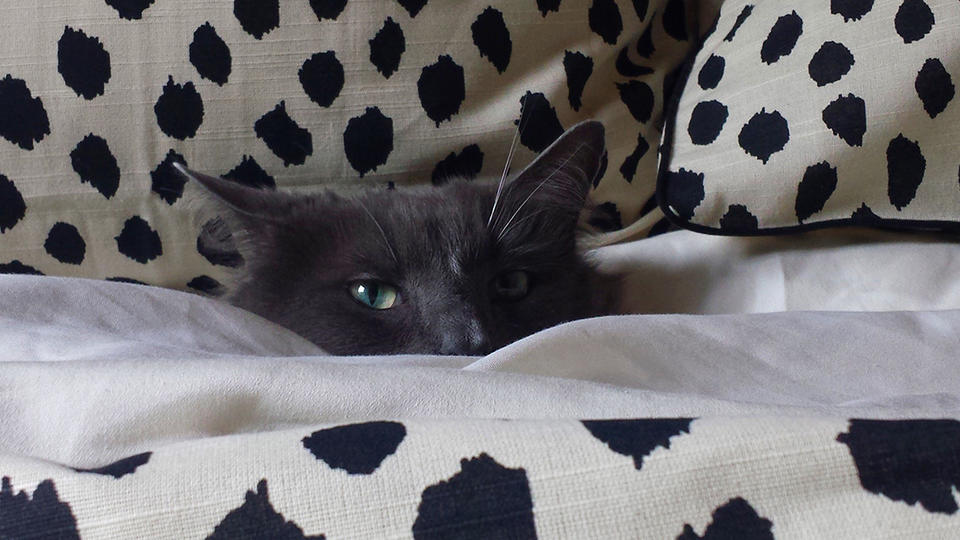
Turning Green
The Emerald City: How The Greening Of Houston Is Transforming The Way We Live
By Allyn West
The Emerald City: How The Greening Of Houston Is Transforming The Way We Live
This article by Allyn West originally appeared in Rice Business, Fall 2016.
Buffalo Bayou Park feels like a perfect public space. Completed in 2015, the redesign of the park along 2.3 miles of Houston’s primary bayou incorporates 10 miles of hike and bike trails and footpaths, a dog park, public art, gardens, bike and kayak rentals, playgrounds. Visitors can tour an abandoned underground reservoir and eat brunch in a glass-walled restaurant raised on concrete pilings that makes them feel as though they’re up among the trees.
Seeing all the sweating cyclists, the parents drinking coffee and pushing strollers, the pedestrians stopping to take selfies with the skyline as a backdrop, you might not believe that this same park was an afterthought. The bayou had become blocked from view by invasive vegetation and its loved-to-death trails used — especially in the evenings — only by diehards. Large swaths of the park were inaccessible and underutilized.
In 2011, with a comprehensive master plan by SWA Group in hand, Buffalo Bayou Partnership led a $55 million redevelopment, which included a $30 million donation from the Kinder Foundation, that catalyzed its transformation into one of the country’s best urban parks. That’s according to a 2016 USA Today reader poll.
But that same poll ranked another Houston urban park even higher: Discovery Green, designed by Hargreaves Associates, came in fourth. Together, these two parks have helped to change the conversation about the city. As Texas Monthly writer Mimi Swartz quips, “Houston doesn’t look like Houston anymore.”
Once defined primarily by its freeways and parking lots and its “almost sensational lack of convivial public space,” as essayist Philip Lopate griped in the ’80s, Houston is now being celebrated as a national model for its investments in places where people can gather to relax, play and exercise. Charles Birnbaum, president and CEO of Washington, D.C.-based The Cultural Landscape Foundation, which was inspired to hold its annual conference here, writes that Houston is “undergoing a transformation … at a scope and scale unseen in the U.S. in more than a century.”
Consider: The underused Levy Park in Upper Kirby, once come to a few baseball diamonds, is being completely redesigned and reprogrammed with a $15 million investment. On the other side of town, historic Emancipation Park in the Third Ward is getting a $33 million redevelopment, including the construction of community center designed by celebrated African-American architect Phil Freelon. A private group hired landscape architecture firm West 8 to conceive of a master plan for a Houston Botanic Garden. And new master plans have been completed to restore and redesign the 155-acre Houston Arboretum and Nature Center and the 1,500-acre Memorial Park.
“It’s a great time for parks in Houston,” says Anne Olson, president of Buffalo Bayou Partnership. “The appreciation of them has grown over the years, and the business community sees more and more the economic impact that they can have.” Olson points to new residential developments currently under construction that are actively marketing their proximity to Buffalo Bayou Park.
“There’s such intense competition for Millennials,” she says. “Parks and open spaces and trails are just one more amenity that they are attracted to.”
But these parks, open spaces and trails are not cheap. Many cities have parks departments that strain to keep up with the demand, and Houston is no exception. As much as the city has been recognized for its development of these amenities, it has been praised for its innovative ways of paying for them. Adrian Benepe of the Trust for Public Land told the Houston Chronicle: “Houston has become a laboratory of interesting solutions for park building, financing and management.” The predominant solution is the public-private partnership.
The land where Discovery Green is, for example, was purchased by the City of Houston in two transactions in 2002 and 2004 on the recommendations of a pair of private philanthropists. But the park is now managed, programmed and maintained by a separate nonprofit conservancy that raises its own money and has its own staff.
Though some critics have argued that these public-private partnerships can lead to inequity, they do allow certain parks to be chosen, so to speak, so as to be better stewarded by private philanthropy, property tax reinvestment and other focused revenue streams.
There’s no doubt they’re effective: another public- private partnership was formed to lead the way on a project that could be even more transformative for Houston than any single park: Bayou Greenways. Bayou Greenways revisits a plan first developed in Houston in the early 1900s by landscape architect Arthur Comey that called for trails and linear parks along the city’s major bayous. Funded through a $166 million public bond in 2012 and private fundraising — including $50 million more from the Kinder Foundation — work is underway building these trails and transforming more than 3,000 acres of land around Houston’s bayous for use for recreation and mobility.
When the project is completed in 2020, 150 miles of trails will line the bayous, connecting neighborhoods to job and retail centers, parks, transit and more.
Beth White is president of the Houston Parks Board. “Houston is one of the most exciting places in the country right now in terms of investments the city is making in quality of life infrastructure,” she explains. “We’ve been doing all these pieces, and now we have this ability to do all this connective tissue that’s going to take this whole effort to a different level.”
White is excited about the multifaceted social and economic impacts that the Bayou Greenways might have, from improvements in public health to increases in property values to investments in neighborhood parks. She imagines that Bayou Greenways will have an effect on Houston similar to that of other ambitious urban projects like The High Line in New York City or the 606 in Chicago.
Not only will the project spark development, White says, it will transform the way the city “views itself and the way it lives. This will have an impact on people wanting to stay here. The power of visionary systems to make cities livable places cannot be overstated. It’s extraordinary."


